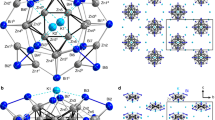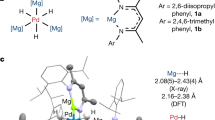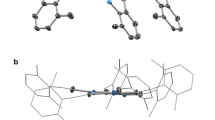Abstract
In polyoxometalate chemistry a large variety of compounds, clusters and solid-state structures can be formed by the linking together of well-defined metal–oxygen building blocks1, 2. These species exhibit unusual topological and electronic properties, andfind applications ranging from medicine3 to industrial processes4. The recently reported ring-shaped mixed-valence polyoxomolybdates of the type {Mo154} (refs 5, 6) and {Mo176} (refs 7, 8) represent a new class of giant clusters with nanometre-sized cavities and interesting properties for host–guest chemistry. Here we describe the formation of related clusters of the type {Mo248} formed by addition of further units to the inner surface of the {Mo176} ‘wheel’. The additional units arrange themselves into two {Mo36} ‘hub-caps’ on the initial wheel—clusters that are not stable in isolation. These findings reveal a new pathway to the development of complex coordination clusters.
This is a preview of subscription content, access via your institution
Access options
Subscribe to this journal
Receive 51 print issues and online access
$199.00 per year
only $3.90 per issue
Buy this article
- Purchase on Springer Link
- Instant access to full article PDF
Prices may be subject to local taxes which are calculated during checkout


Similar content being viewed by others
References
Müller, A. & Pope, M. T. in From Simplicity to Complexity Part II: Information—Interaction—Emergence (eds Mainzer, K., Müller, A. & Saltzer, W. G.) 57–68 (Vieweg, Braunschweig, (1998).
Pope, M. T. & Müller, A. Polyoxometalate chemistry: an old field with new dimensions in several disciplines. Angew. Chem. Int. Edn Engl. 30, 34–48 (1991).
Rhule, J. T., Hill, C. L., Judd, D. A. & Schinazi, R. F. Polyoxometalates in medicine. Chem. Rev. 98, 327– 357 (1998).
Katsoulis, D. E. Asurvey of applications of polyoxometalates. Chem. Rev. 98, 359–387 (1998).
Müller, A. et al. [Mo154 (NO)14O420 (OH) 28 (H2O)70](25±5)− : a water-soluble big wheel with more than 700 atoms and a relative molecular mass of about 24000. Angew. Chem. Int. Edn Engl. 34, 2122 –2124 (1995).
Müller, A., Peters, F., Pope, M. T. & Gatteschi, D. Polyoxometalates: very large clusters—nanoscale magnets. Chem. Rev. 98, 239–271 (1998).
Müller, A. et al. Formation of a ring-shaped reduced ‘metal oxide’ with the simple composition [(MoO3)176 (H2O) 80H32]. Angew. Chem. Int. Edn Engl. 37, 1220–1223 (1998).
Müller, A., Koop, M., Bögge, H., Schmidtmann, M. & Beugholt, C. Exchanged ligands on the surface of a giant cluster: [(MoO3)176 (H2O)63 (CH3OH) 17Hn](32-n)- . J. Chem. Soc., Chem. Commun. 1501–1502 (1998).
Williams, N. H. & Yandell, J. K. Outer-sphere electron-transfer reactions of ascorbate anions. Aust. J. Chem. 35, 1133–1144 ( 1982).
Müller, A. et al. Unusual stepwise assembly and molecular growth: [H14 Mo37O112]14− and [H 3Mo57V6 (NO)6O189 (H 2O)12 (MoO)6]21− . Chem. Eur. J. 4, 1000–1006 (1998).
Müller, A. et al. Comparative in-vivo and in-vitro99 Mo-time-differential-perturbed-angular-correlation studies on the nitrogenase MoFe protein and on other Mo species of different N2-fixing bacteria. Eur. J. Biochem. 246, 311– 319 (1997).
Robin, M. B. & Day, P. Mixed valence chemistry- a survey and classification. Inorg. Chem. Radiochem. 10, 247–422 (1967).
Acknowledgements
We thank E. Krickemeyer, B. Hauptfleisch, C. Beugholt, E. Diemann and F. Peters for their collaboration. This work was supported by the Deutsche Forschungsgemeinschaft and the Fonds der Chemischen Industrie.
Author information
Authors and Affiliations
Corresponding author
Rights and permissions
About this article
Cite this article
Müller, A., Shah, S., Bögge, H. et al. Molecular growth from a Mo176 to a Mo248 cluster . Nature 397, 48–50 (1999). https://doi.org/10.1038/16215
Received:
Accepted:
Issue Date:
DOI: https://doi.org/10.1038/16215
This article is cited by
-
Ce-mediated molecular tailoring on gigantic polyoxometalate {Mo132} into half-closed {Ce11Mo96} for high proton conduction
Nature Communications (2023)
-
Engineering in amino acid-functionalized double-layer heteropolymolybdates: from structural control to catalytic activity
Rare Metals (2023)
-
Largest 3d-4f 196-nuclear Gd158Co38 clusters with excellent magnetic cooling
Science China Chemistry (2022)
-
Assembly of a Two-Fold Interpenetrated Three-Dimensional Metal–Organic Framework by Using the Template Function of Keggin Anions
Journal of Cluster Science (2018)
-
Development of copper-stabilized conducting-polymer/polyoxometalate hybrid materials for effective electrochemical charging
Journal of Solid State Electrochemistry (2017)
Comments
By submitting a comment you agree to abide by our Terms and Community Guidelines. If you find something abusive or that does not comply with our terms or guidelines please flag it as inappropriate.



